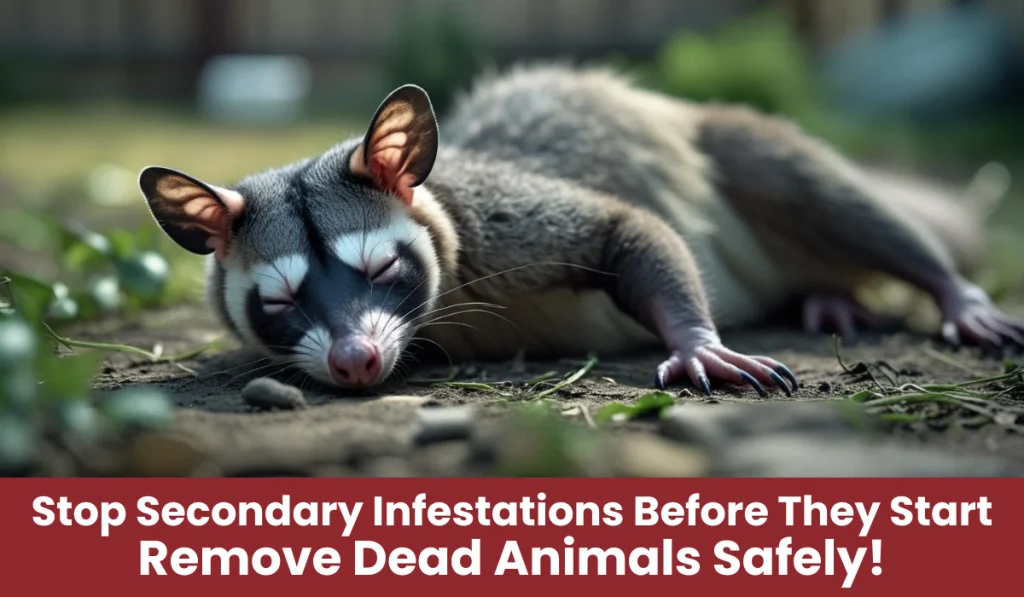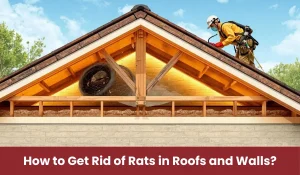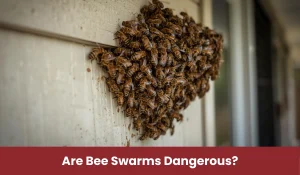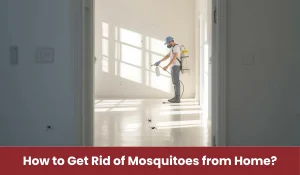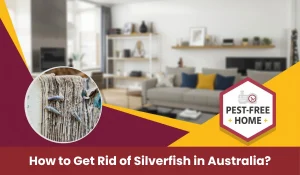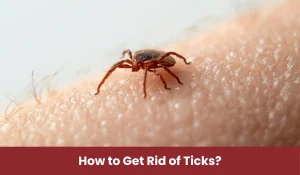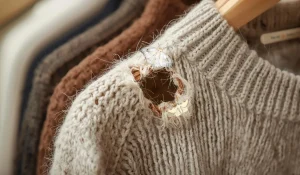It’s easy to ignore a strange smell or the occasional fly in the house until it gets worse. Suddenly, you’re dealing with an overpowering stench, bugs showing up out of nowhere, and a creeping feeling that something’s gone wrong behind your walls. In many cases, it all starts with a hidden carcass.
If you’ve ever had a dead animal in the roof or wall, you’ll know just how quickly things can escalate. In this article, we’ll explore how a single dead rodent or possum can trigger secondary pest infestations, and why quick, professional intervention is key to protecting your home and your health.
What Happens When an Animal Dies Inside Your Property?
When an animal dies in a confined space like an attic, crawlspace, or behind the walls, its body starts decomposing within hours. That process:
- Releases gases and fluids that seep into insulation and timber
- Attracts insects, especially blowflies
- Creates an unbearable foul smell from dead rodent decay
- Spreads bacteria into the surrounding environment
How Dead Animals Trigger Pest Infestations?
So does a dead animal attract pests? Absolutely.
Once decomposition kicks in, the scent draws in all kinds of unwanted visitors. Here’s how it snowballs:
- Flies from dead animal carcasses arrive within hours and lay eggs
- These eggs hatch into maggots from dead animal, which spread bacteria and crawl into other parts of your home
- Beetles, ants, and mites join in, feeding on tissues and bodily fluids
- Rats or mice might be drawn to the scent, thinking there’s food or shelter
That one possum or rat can now create an infestation involving several types of pests, all harder to deal with than the original issue.
Health Risks of a Decomposing Carcass
The health risks of decomposing animals are real. As the body breaks down, it becomes a breeding ground for harmful pathogens like:
- Salmonella
- E. coli
- Leptospirosis
- Hantavirus (especially from rodents)
Even if you’re not touching the animal directly, airborne particles, droppings, and pests like flies or maggots can carry these into your living areas.
Children, elderly people, and pets are especially vulnerable to infections caused by bacteria from animal carcass exposure.
Why You Shouldn’t DIY It?
While it might seem like a quick fix to try and remove the carcass yourself, DIY jobs can go horribly wrong. Without the right gear, you might:
- Miss smaller remains like bones or bodily fluids
- Fail to clean or disinfect the area thoroughly
- Expose yourself to dangerous bacteria or sharp insulation
- Risk another infestation from the pests already present
That’s why most people call in carcass removal services to handle it properly. They have the tools, training, and experience to do the job safely and completely.
What a Professional Removal Involves?
Here’s what you can expect when you contact a team that specialises in professional carcass disposal:
- Inspection – Professional disposers use smell, heat detectors, or small cameras to find exactly where the dead animal is hidden in your home.
- Removal – The team safely removes the dead animal using gloves, tools, and protective gear to avoid spreading germs or causing damage.
- Sanitisation – They clean the area using strong disinfectants and sprays to remove any germs, bad smells, and leftover fluids from the carcass.
- Pest Control – If flies, maggots, or other pests are found near the carcass, they are also removed and the area treated properly.
- Prevention – Openings in your roof or walls are sealed to stop more animals from entering and dying inside again in the future.
This process is often done in a single visit and follows local health and safety laws.
Signs You Need Immediate Action
Don’t wait until the problem spreads. Contact emergency dead animal removal Australia experts if you notice:
- Persistent rotting smell indoors
- Increase in flies, beetles, or ants
- Buzzing near vents, lights, or outlets
- Pets showing unusual interest in a particular spot
- Flu‑like symptoms with no clear cause
Even one dead rat pest problem can escalate quickly, especially in summer when pests multiply faster.
Why Timing Matters?
Wondering why remove dead animals quickly? Because the longer you wait, the worse the consequences. Not only do pest populations grow, but the fluids from decomposition can permanently damage insulation, timber, and plaster.
Secondary infestations can cost hundreds to thousands of dollars in pest control, repairs, and replacement of contaminated materials. Quick action saves both money and stress.
Real Australian Examples: What Locals Face
In many Australian suburbs, especially those close to bushland, removing dead possum or rats is a common callout. Possums often get trapped in roof cavities, chew through wiring, and die in difficult-to-reach spots.
In many Australian suburbs, especially those close to bushland, removing dead possum or rats is a common callout. Possums often get trapped in roof cavities, chew through wiring, and die in difficult-to-reach spots.
Final Thoughts
In the end, dead animal removal is your first line of defence against nasty smells, buzzing flies, and unwelcome bugs. By calling in professionals, you stop one problem from turning into a full‑blown secondary pest infestation nightmare. At True Pest Control, we treat every job with care, using safe methods to clear out carcasses and protect your home. Don’t wait for maggots or rodents to move in. Take action today and reach out to True Pest Control on 0480022718 for friendly, 24/7 service. We’re here to help keep your home fresh, healthy, and pest‑free.

